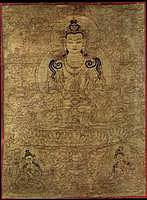
|
Tathagata Amitayus (painting no. 524)
|

View Larger Image |
||||||||||||||
|
Below Amitayus, the "Buddha of Limitless Life" sits Ushnisavivajaya (Tib.: Namgyalma) to the left and White Tara to the right. This triad is associated with a very popular longevity meditation. M. Mokotoff 2-98 AMITAYUS, also known as Aparamitayus. (Tibetan: sang gye tse pa me, English: the Buddha of Immortal Life). Amitabha appearing in the sambhogakaya form (enjoyment body of a buddha). "...with a body the colour of a lump of coral or the rising sun, very red and shining forth with various coloured rays of light; one face, two hands, and with two long eyes glancing with compassion on beings, gazing on the entirety of migrators, and a smiling face; having the hair in tufts, bound on top, the remainder falling loose; wearing complete sambhogakaya vestments. Held above the two hands performing the mudra of meditative equipoise is a gold long-life vase filled with the nectar of immortality; adorned with jewel ornaments; wearing garments of various silks; shining with the marks and examples; seated in vajra posture." - Zhuchen Tsultrim Rinchen (1697-1769). Amitayus has the appearance of a youth of 16 years, slim, well proportioned with long black flowing hair, seated in the vajra posture. At the bottom left is the goddess, Ushnishavijaya, (Tib.: nam par gyal ma) " …the colour of an autumn moon; with three faces, white, yellow and blue and eight hands. Each face has three very large eyes. The first right hand holds a visvavajra; second a white lotus with Amitabha residing; third, an arrow and fourth, in supreme generosity. The first left holds a vajra lasso; second, a bow; third, bestowing protection and fourth in meditative equipoise holding an auspicious nectar vase; complete with silks and jewel ornaments; seated in [vajra] posture." - Jamyang Khyentse Wangpo (1820-1892). At the bottom right is White Tara (Tib.: drol ma kar mo); "…with a hue white like an autumn moon - radiant like a stainless crystal jewel, shining with rays of light; with one face, two hands and having three eyes; with the conduct of having sixteen years of age. The right hand is in the mudra of supreme generosity. The left holds with the thumb and forefinger the stem of a white utpala to the heart with the petals blossoming at the ear. To represent the buddhas of the three times the single stem is divided into three; in the middle is a blossoming flower, the right in fruition, the left in the form of a bud. Adorned with various jewel ornaments, having upper garments of various silks and a lower garment of red silk, [she is] seated with the legs in vajra posture. The palms of the hands and feet each have an eye - the seven eyes of pristine awareness. The back is supported by a moon with white light." - Sakya Trizin Kunga Lodro (1729-1783). In Tibetan these three figures are known as the 'Tse Lha Nam Sum,' the Three Long-life Deities. Each can be practiced individually however many prayers and praises include all three. Belonging to the Kriya Tantra classification they have been grouped as a set according to Tibetan aesthetics. The method of painting is called 'ser thang.' The entire ground is painted with gold and the deities are painted in outline with dark red or brown pigments. J.Watt 5-98
|
|||||||||||||||
Photographed Image Copyright © 1998 Shelley & Donald Rubin Foundation
|
|
| |
Next Image |